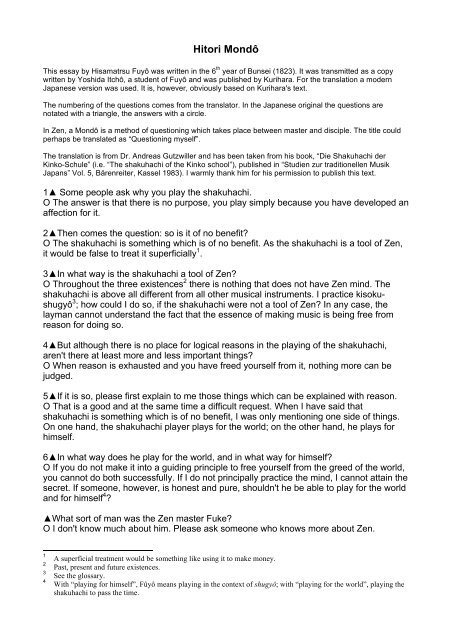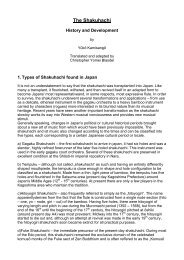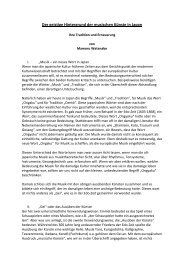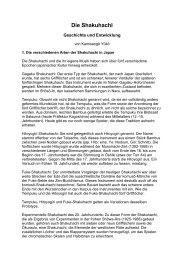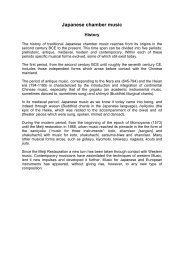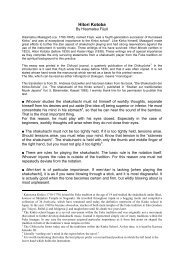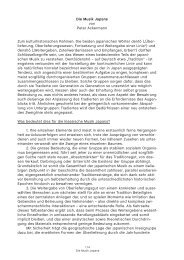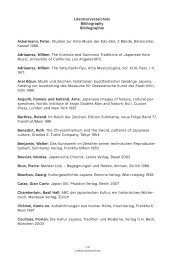Hitori Mondô - komuso
Hitori Mondô - komuso
Hitori Mondô - komuso
Create successful ePaper yourself
Turn your PDF publications into a flip-book with our unique Google optimized e-Paper software.
<strong>Hitori</strong> <strong>Mondô</strong><br />
This essay by Hisamatrsu Fuyô was written in the 6 th year of Bunsei (1823). It was transmitted as a copy<br />
written by Yoshida Itchô, a student of Fuyô and was published by Kurihara. For the translation a modern<br />
Japanese version was used. It is, however, obviously based on Kurihara's text.<br />
The numbering of the questions comes from the translator. In the Japanese original the questions are<br />
notated with a triangle, the answers with a circle.<br />
In Zen, a <strong>Mondô</strong> is a method of questioning which takes place between master and disciple. The title could<br />
perhaps be translated as “Questioning myself”.<br />
The translation is from Dr. Andreas Gutzwiller and has been taken from his book, “Die Shakuhachi der<br />
Kinko-Schule” (i.e. “The shakuhachi of the Kinko school”), published in “Studien zur traditionellen Musik<br />
Japans” Vol. 5, Bärenreiter, Kassel 1983). I warmly thank him for his permission to publish this text.<br />
1▲ Some people ask why you play the shakuhachi.<br />
Ο The answer is that there is no purpose, you play simply because you have developed an<br />
affection for it.<br />
2▲Then comes the question: so is it of no benefit?<br />
Ο The shakuhachi is something which is of no benefit. As the shakuhachi is a tool of Zen,<br />
it would be false to treat it superficially 1 .<br />
3▲In what way is the shakuhachi a tool of Zen?<br />
Ο Throughout the three existences 2 there is nothing that does not have Zen mind. The<br />
shakuhachi is above all different from all other musical instruments. I practice kisokushugyô<br />
3 ; how could I do so, if the shakuhachi were not a tool of Zen? In any case, the<br />
layman cannot understand the fact that the essence of making music is being free from<br />
reason for doing so.<br />
4▲But although there is no place for logical reasons in the playing of the shakuhachi,<br />
aren't there at least more and less important things?<br />
Ο When reason is exhausted and you have freed yourself from it, nothing more can be<br />
judged.<br />
5▲If it is so, please first explain to me those things which can be explained with reason.<br />
Ο That is a good and at the same time a difficult request. When I have said that<br />
shakuhachi is something which is of no benefit, I was only mentioning one side of things.<br />
On one hand, the shakuhachi player plays for the world; on the other hand, he plays for<br />
himself.<br />
6▲In what way does he play for the world, and in what way for himself?<br />
Ο If you do not make it into a guiding principle to free yourself from the greed of the world,<br />
you cannot do both successfully. If I do not principally practice the mind, I cannot attain the<br />
secret. If someone, however, is honest and pure, shouldn't he be able to play for the world<br />
and for himself 4 ?<br />
▲What sort of man was the Zen master Fuke?<br />
Ο I don't know much about him. Please ask someone who knows more about Zen.<br />
1<br />
A superficial treatment would be something like using it to make money.<br />
2<br />
Past, present and future existences.<br />
3<br />
See the glossary.<br />
4<br />
With “playing for himself”, Fûyô means playing in the context of shugyô; with “playing for the world”, playing the<br />
shakuhachi to pass the time.
7▲Wasn't Fuke the founder of the shakuhachi? If you have chosen this path and don't<br />
know about its origins, aren't you incompetent?<br />
Ο I know indeed about the origin of the shakuhachi. However, I know little of Fuke. He was<br />
a very enlightened man, but is it as if he sought the way of enlightenment with help from<br />
the shakuhachi 5 ?<br />
Someone like myself, without knowledge and enlightenment, and who plays the<br />
shakuhachi simply because he likes to do so can nonetheless bit by bit recognize the<br />
shakuhachi as a tool of Zen and see that there is no difference between nonunderstanding<br />
and understanding 6 .<br />
Even if Fuke had played the shakuhachi, he only would have been able to play around a<br />
bit on the instrument. When it comes to the art of playing the shakuhachi, even I after<br />
many years am still not accomplished. Still, if Fuke were now to come back to life, he<br />
would certainly become by disciple and would ask me for advice in these matters.<br />
If we were to see records from the time of Fuke, we could learn everything about him. But<br />
if you don't possess his enlightenment, you won't really understand. Someone who knows<br />
nothing about Fuke, but has his degree of enlightenment, will understand him. I don't<br />
understand him yet.<br />
8▲Does the shakuhachi have twelve ritsu 7 ?<br />
Ο The shakuhachi, be it long or short, thick or thin, embodies only one principle 8 . It doesn't<br />
possess the twelve ritsu. The twelve ritsu are an organizing principle for the universe 9 and<br />
for human beings. If someone manages, even if only for a short time, to encompass the<br />
twelve ritsu of the universe within the body of the shakuhachi, you can distinctly feel it. If<br />
you feel the universal twelve ritsu, the human twelve ritsu appear automatically.<br />
In any case, people are according to their character more or less receptive towards this<br />
manifestation of the ritsu. This remains incomprehensible to an unreceptive person, even if<br />
you explain it to him. For someone who knows, this understanding develops naturally.<br />
9▲Does it have a special significance that the shakuhachi has four holes in front and one<br />
behind, that it has seven nodes and that it is one foot and eight inches long?<br />
Ο The shakuhachi is a Zen instrument, and because it is one foot eight inches long is was<br />
named the shakuhachi 10 . But because it represents the entire universe and the principle of<br />
yin and yang its meaning cannot be exhausted by a single name. If I knew about these<br />
things and gave the shakuhachi various names and could present everything thoroughly, I<br />
wouldn't play any better; and if I didn't know, I wouldn't play any worse. I will never know.<br />
In my opinion, the shakuhachi is an instrument to be played.<br />
10▲Some count the shakuhachi's holes from bottom to top and some from top to bottom.<br />
Which is right and which is wrong?<br />
Ο Both are right and both are wrong. The method of counting is manmade and isn't part of<br />
the nature of the shakuhachi. Someone who counts the holes from top to bottom is right,<br />
someone who counts them from bottom to top is also right. Someone who wants to count<br />
outwards from the middle should do so.<br />
Because I learned to count from bottom to top I consider this way to be correct. When one<br />
has reached the level of mastery, it is natural to count from the bottom. Reaching this level<br />
is like awakening from a dream. If you, however, investigate these many matters, you will<br />
5<br />
Although Fuke is the founder of this sect, he did not himself play shakuhachi.<br />
6<br />
This is my attempt to translate the last part of this phrase.<br />
7<br />
In this section, Fûyô plays with the term “ritsu” (half-tone, ordering principle). The 12 ritsu which are asked about<br />
here are the 12 tones of the Sino-Japanese tonal system.<br />
8<br />
Ichiritsu.<br />
9<br />
The 12 astrological signs.<br />
10<br />
Shaku: “foot” (as a unit of measurement); hachi: “eight”. The name is thus an abbreviation of a description of the<br />
length of the instrument, isshaku hassun: “1 foot, 8 inches”.
only waste your time.<br />
11▲For the shakuhachi one used the lower part of the bamboo, for the hitoyogiri, the top.<br />
What is the difference?<br />
Ο It is worthless to discuss this question. The human mind could extend over the entire<br />
world, but because people are limited in their possibilities they cannot move. Your question<br />
is as limited as the vision of a frog in a well; you're only making a fool out of yourself.<br />
Wasn't it established in ancient times that the shakuhachi should have seven nodes 11 ?<br />
Aren't pipes with five or six nodes also called shakuhachi these days? The human mind<br />
might have changed since ancient times, but it hasn't gotten any wiser.<br />
When it comes to the number of nodes and the length of the shakuhachi, I follow my<br />
intuition. Shouldn't one respect the number of the nodes and the form of the bamboo? One<br />
needn't break with tradition, but at the same time one shouldn't cling to old empty<br />
appearances.<br />
There is the shakuhachi as a tool of Zen and the shakuhachi as a means of passing the<br />
time. The shakuhachi as a tool of zen is the essence; the shakuhachi as a means of<br />
passing the time in the substance 12 . Many people play the shakuhachi as a leisurely<br />
pastime. Those who treat the shakuhachi as a tool of zen are rare. I practice shugyô with<br />
the shakuhachi as a tool of Zen and therefore don't worry whether it is long or short nor<br />
about how many nodes it has.<br />
12▲About when was the number of pieces in the Kinko School set at 36?<br />
Ο Kinko III told me that Kinko I already set the number of “fore” and “rear” pieces at 36; the<br />
number of secret pieces, however, were three 13 . But I didn't hear this myself from Kinko I<br />
so I do not know.<br />
13▲About when was the notation of the pieces established?<br />
Ο Kinko II and Ikkan, a disciple of Kinko I, as I have heard, established the notation of the<br />
pieces. But I haven't heard it from them myself so I do not know.<br />
14▲If someone can play each piece without deviating from the notation, doesn't that make<br />
him a good shakuhachi player?<br />
Ο Not in the least! Someone who plays the pieces without deviation has indeed a good<br />
memory, but this isn't enough to make him a good shakuhachi player. It isn't difficult to<br />
memorize the 36 pieces, like a guard to the notation. Everyone can learn one piece per<br />
month, but it isn't the number of pieces learned which makes a good player, but rather how<br />
he plays a piece.<br />
39 pieces are 36 pieces 14 ,<br />
36 pieces are 18 pieces 15 ,<br />
18 pieces are three pieces 16 ,<br />
Three pieces are one piece,<br />
one pieces is no piece,<br />
no piece is the breath of the mind 17 ,<br />
11<br />
The true Fuke Shakuhachi had only three nodes and was not made from the lowest part of the bamboo, including the<br />
three uppermost root-nodes. It cannot be said with certainty exactly when the development of the shakuhachi of 7<br />
nodes took place.<br />
12<br />
Essence (kyo) and substance (jitsu) are terms from Japanese poetic theory. The meaning is not completely clear here,<br />
other than that “essence” is more highly esteemed, as it is associated with shugyô, whereas “substance” is connected<br />
with passing the time (yûgi). Toyoshima interpreted kyo as butsu (no oto), the “tone of Buddha”, and jitsu as<br />
shikiyoko no oto, the “tone of desire”.<br />
13<br />
According to the oldest documents, going back to before the time of Fûyû, the original repertoire consisted of only<br />
35 or 36 pieces.<br />
14<br />
The entire repertoire with the exception of the three secret pieces (hikyoku).<br />
15<br />
The 18 “fore” pieces.<br />
16<br />
The three oldest pieces (koden sankyoku), Shin Kyorei, Kokû Reibo and Mukaiji Reibo.
the breath of the mind is nothing besides emptiness and nothingness.<br />
What meaning could the number of pieces learned possibly have?<br />
15▲So is it allowed to deviate from the notation of the pieces?<br />
Ο It is an offence to deviate from the notation. Kinko II and Ikkan feared that the tradition of<br />
the shakuhachi would fall into disorder and therefore fixed the notated form of the pieces.<br />
To play from the onset according to ones one’s discretion is false. Although one can still<br />
hear the beauty of the bamboo's sound, you cannot recognize the nature of the<br />
shakuhachi as a tool of Zen. However, if someone plays the shakuhachi and realized that<br />
it isn't merely a shakuhachi, but rather a tool of Zen, this person doesn't have to worry<br />
about the fixed notation. The pieces are set in notation in order to help the beginner to the<br />
essence of the shakuhachi. Wouldn't it be an offence to compromise this?<br />
16▲When you play, do you deviate from the notation?<br />
Ο I do not deviate, but my way of playing is very different from another's. For example: you<br />
are a person and I am a person. Your body, your hair, your inner organs are like those of<br />
other people, but yet you are very different from them. So: think for yourself about the<br />
difference between deviation from the notation and non-deviation!<br />
17▲How does one recognize a good player and how does one recognize a master?<br />
Ο Treating the shakuhachi like a living thing makes a good player. The secret is that a<br />
master plays like nature itself and doesn't simply show off his technique. When he does<br />
not abandon this, he cannot pass the threshold of mastery. I become the bamboo, the<br />
bamboo becomes me.<br />
Whoever is in the essence and works on the substance, that person is a master. No matter<br />
what piece he plays, it becomes “the mind of emptiness” 18 . Making this expression “the<br />
mind of emptiness” into the foundation of music – that is the essence. It is also the<br />
essence not to separate the three pieces 19 from the others. Naming emptiness and<br />
nothingness is also the essence. The reason I practice shugyô wholeheartedly is to be in<br />
the essence and to work on the substance 20 .<br />
For the unschooled this is hard to understand.<br />
18▲Are there masters to be found nowadays?<br />
Ο There isn't a single one. I don't see either any who have understood shugyô.<br />
19▲Are you a master, a good player or a poor player?<br />
Ο I am a master, I am a good player and I am a poor player.<br />
What makes me a master is that I know the threshold of mastery, and yet I cannot cross it.<br />
I am a good player, because I try to become a good player, but I cannot attain this. So I’m<br />
a very bad player, am I not?<br />
20▲Can you be compared to any contemporary players?<br />
Ο I don't resemble whoever you might compare me to. If you compare me to another I do<br />
not reach their level. If you compare someone else to me, they don't reach my level. The<br />
less you compare me to others, the better.<br />
17<br />
Kisoku.<br />
18<br />
Kyorei. This is the most common way the Kinko School reads the title of the “original pieces” of the Fuke School,<br />
which Hottô Kokushi is said to have brought with him from China.<br />
19<br />
Either the three secret pieces or koden sankyoku, the three central pieces of the Fuke School. The latter is more<br />
likely.<br />
20<br />
For “essence” and “substance”, please see above. If I have correctly understood the second part of this response, it<br />
means that for the person who executes shugyô with his entire heart, the difference between playing the shakuhachi<br />
as a spiritual practice (kyo: essence) and playing as a pastime (jitsu: substance) becomes irrelevant. For the person<br />
who plays with right mind, each piece becomes kyorei, “the mind of emptiness”.
When my thoughts and wishes, by tendencies and worries become one, then I will<br />
automatically become a good player and a master. Only when I earnestly study the way<br />
will I become happy and reach my goal at the right time.<br />
Not even in their dreams are humans occupied with such things!<br />
Bamboo should be blown, the questioner should be quiet, his mouth should close.<br />
I entitle this essay <strong>Hitori</strong> Mondo. What an offence to have wasted paper and ink like this!<br />
Written in late autumn of the sixth year of Bunsei.<br />
The Hermit of Edo, Fûyô Kanteisei


